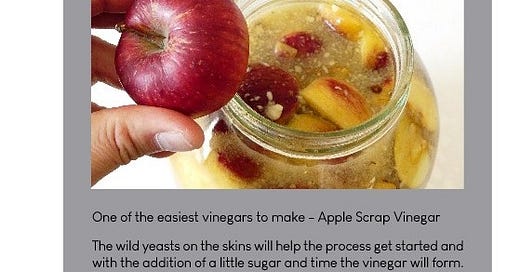Food goes bad chiefly for one reason. It is attacked by minute organisms which, given the right conditions, will grow rapidly and destroy the structure of the produce. Most of them are quite harmless and some are even encouraged - in blue cheese production for instance.
The object of pickling is to treat the food so that the organisms that would attack it cannot grow and the food is preserved. Vinegar is the principal agent in achieving this in pickles but sugar and salt also play their part.
To achieve a successful pickle or chutney the final acidity must be in the region of 3% if the pickles are to keep but there is no easy way to test this in the home environment. The average acidity of vinegar must be around 5% and as most fruit and vegetables are made up of a large volume of water if we just added the vinegar to unprepared vegetables the vinegar would be diluted to a level that would not preserve the produce. Fermentation would soon begin and yeasts and moulds would soon proliferate.
You may come across a product called Non-brewed Condiment which, although not fermented, looks and smells like vinegar but it is not suitable as a preservative - great on your chips from the chippy though.
The water is therefore removed from the produce by the process of osmosis by adding salt to the prepared vegetables or fruit which draws out the excess water. Once the vinegar is added in the pickling process it replaces the water in the cells of the vegetables and preserves them.
Vinegars are produced by the action of an acetic bacterium on alcohol and the type of vinegars produced used to follow the national drink of a country - wine vinegars in France, malt vinegars in Britain etc. We are fortunate these days to have a wide variety of vinegars available to us at a reasonable cost. Even thirty years ago malt vinegar and distilled malt vinegar would have been the only affordable options. So, when thinking about your recipe - especially if it is from an old recipe book, maybe replace the malt vinegar with something that will support and enhance your other ingredients. Cider vinegar with apples, red wine vinegar with plums etc.
Vinegar brewers have a long and ancient history and it is a very precise skill governed by very strict laws to protect the very powerful preserving qualities. I have always said that if Vinegar Brewmaster had been on the list of my Careers Adviser at school my life would have been very different!
It is actually very simple to make your own vinegars from a variety of basic ingredients. In fact, anything such as fruit juice, which eventually ferments producing alcohol, will make itself into vinegar if left long enough! That brew will develop a ‘vinegar mother’ which is a jelly-like disc that forms naturally and usually floats on or just below the surface - this is made up of cellulose, yeast and bacteria ( all good ) and aids the development of acetic acid turning the wine into vinegar.
You can get a head start with this by using a quantity of unpasteurised or ‘raw’ cider vinegar which states on the bottle ‘with Mother’. This will kick start the fermentation and you should see - or rather smell - vinegary results in two to three weeks. I like to have a vinegar jar, complete with a little wooden tap, on the counter for adding my own red wine vinegar to my everyday cooking. However, there are several very good books on the market which describe in detail the myriad of vinegars achievable, mostly from foraged material. Literally a vinegar for every occasion.
For the definitive vinegar bible you need The Vinegar Cupboard on your shelf. Written by Angela Clutton I do not think that there is any other vinegary fact that you could discover that is not in this book! My favourite book for home-made vinegar is Wildcrafted Vinegars by Pascal Bauder. The ‘no commission earned’ details are below.
So, to conclude this series on the three main natural ingredients essential for the safe preservation of food, we have the miracle of vinegar, which will make itself from ripe fruit which produce alcohols which will be turned into vinegar by the Acetobacter bacteria. This can then be used in fermentations to preserve our food, or in pickling if of sufficient strength.
I am in wonder at the natural World. It never fails to lift my spirits, to realise every time I teach this, that it is still the same after many thousands of years and long may it continue.
Resources
https://www.lovejars.co.uk/rosies-preserving-school/library/66-vinegar
The Vinegar Cupboard by Angela Clutton ISBN 978-1-4729-5811-2
Wildcrafted Vinegars by Pascal Baudar ISBN 978-1-64502-114-8
Simply Preserved Magazine Spring issue
Next time . . . . .Pressure Canning




